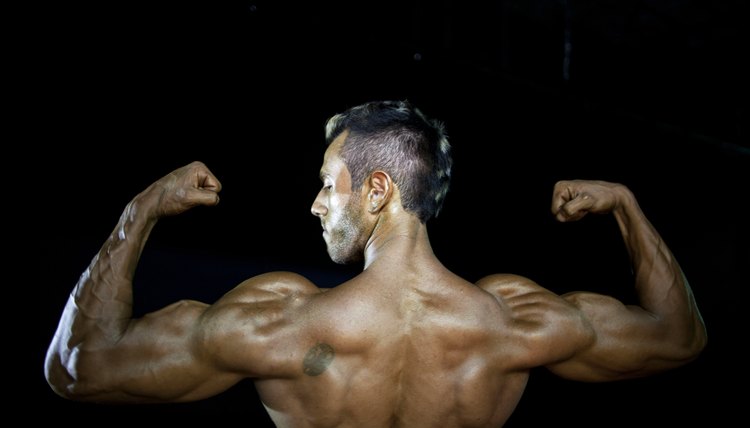Deltoid Vs. Arm Size

Building big muscles is all well and good, but you need your physique to be balanced if you want to stand out from the crowd. Having one body part much bigger than another not only looks odd, but it can also lead to strength imbalances and injuries. This is certainly true when it comes to your deltoids and arms.
Deltoid Size
Your deltoids, or shoulder muscles, have three different parts -- the anterior, medial and posterior head. Use both multi-joint compound moves and single-joint isolations to build your delts, advises personal trainer and bodybuilder Peter Chown. Compounds generally work all three heads and include overhead presses with barbells, dumbbells or on a machine. Isolations focus on one specific head, such as front raises for the anterior head, lateral raises for the medial head and bent-over laterals for the posterior. Strength coach Nick Tumminello recommends performing compounds before isolations and working mainly in the six- to 15-repetitions-per-set range.
Arm Size
Your arms can be classed as two main muscles -- the biceps on the front and the triceps on the rear. Your triceps actually make up two thirds of your upper-arm musculature, according to coach Charles Poliquin of the Poliquin Performance Center. Like shoulders, perform both compound and isolation moves for your arms. Compounds include close-grip bench presses and dips for the triceps, and chinups or wide-grip pullups for your biceps. Perform cable press-downs and dumbbell or barbell extensions to isolate your triceps and different variations of curls to target your biceps.
The Perfect Ratio
The most important aspect when it comes to deltoid and arm size is that you feel both muscles are in equal proportion and that neither overshadows the other. If you want a more accurate gauge, however, former champion bodybuilder Steve Reeves devised a formula to calculate the ideal male physique ratios. According to Reeves, your arms should be 252 percent of your wrist size. He didn't give a ratio for arm-to-delt size, but Ken Gibson of Awesome Physique recommends aiming for a shoulder-to-waist measurement ratio of 1.618 to 1.
Imbalances
Apart from making your physique look out of kilter, a big difference in delt and arm size can be problematic and cause injuries. If your biceps are over-developed, it can start to irritate the tendons around the anterior shoulder, notes trainer Eric Cressey, owner of Cressey Performance in Boston. Likewise, if your shoulders are out of proportion with your biceps, they can internally rotate, which may lead to future rotator cuff injuries or biceps tears.
References
- More-Athletic Magazine: Bodybuilding Basics - Shoulder Training
- Muscle Mag: Nick Tumminello’s Full Spectrum Bodybuilding: Shoulders
- Charles Poliquin: Try this Great Routine for Triceps Mass
- Awesome Physique: The Science of Looking Awesome
- Eric Cressey: 3 Coaching Cues for Strength and Conditioning Programs – Shoulder Edition
Writer Bio
Mike Samuels started writing for his own fitness website and local publications in 2008. He graduated from Peter Symonds College in the UK with A Levels in law, business and sports science, and is a fully qualified personal trainer, sports massage therapist and corrective exercise specialist with accreditations from Premier Global International.
